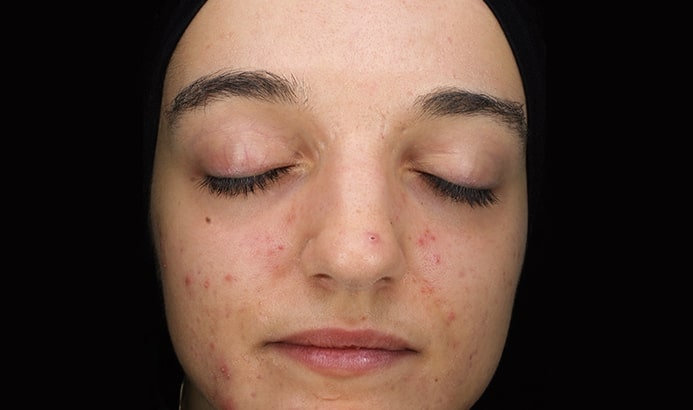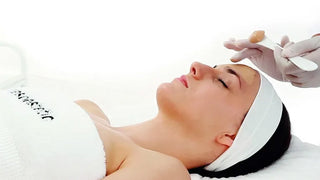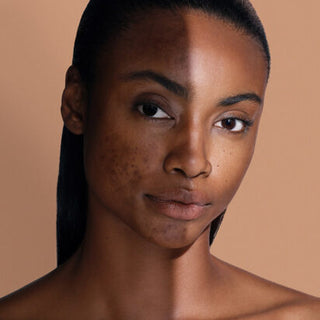Marks or blemishes on the skin from acne can lead to low esteem and make people suffer. They can vary in colour from pink to brown or even black. Although they are often temporary and disappear with time, they can persist for months or even years if not properly treated.
What are acne marks?
Acne marks, also known as post-inflammatory hyperpigmentation (PIH), are specific areas of skin that darken due to previous inflammation caused by acne.
Why do they appear?
The appearance of acne marks is caused by two main things:
- The first is the damage to the skin: inflammation in the skin can damage its structure and increase melanin production, resulting in increased pigmentation. This additional pigmentation is what causes post-inflammatory hyperpigmentation, i.e. acne marks.
- The second is exposure to the sun, which also stimulates melanin production, making the spot darker.
Post-inflammatory hyperpigmentation may be more evident in people with darker skin, as they tend to produce more melanin in response to inflammation.
How to avoid getting acne marks?
Prevention is the best way to avoid the appearance of a mark or blemish where there has been a pimple. Treating acne early and adequately can reduce the risk of developing these spots in the first place. Here are some tips:
- Protect your skin from the sun: sun exposure is the main factor that causes acne spots to darken, so it is essential to apply sunscreen with very high, broad-spectrum sun protection factor, even on cloudy days or indoors. This will help prevent dark acne marks.
- Don't touch your pimples: Touching the wounds can aggravate them and make the dark spots much more visible. Avoid touching them at all costs.
- Depigmenting products: You can use typical products containing depigmentation ingredients, such as tranexamic acid, Vitamin C or glycolic acid. These products help to reduce hyperpigmentation and gradually lighten spots.
- Retinol: Retinol helps to accelerate skin cell renewal and reduce pigmentation. Remember that it is essential to progressively introduce it into your skincare routine in the evening and moisturise your skin to prevent it from becoming irritated. Retinol is contraindicated in pregnant women and women planning pregnancy.
- Gentle exfoliation: Exfoliation with a gentle facial scrub facilitates the removal of dead skin cells and improves skin texture, making acne spots less noticeable.
How to get rid of acne marks?
Products for home use
blemiderm® treatment
Cream gel that corrects the imperfections caused by acne.
Its formula with 10% azelaic acid and liposomed retinol stimulates skin renewal and regulates sebum production. It includes the blemiclear complex, designed to regulate the mechanisms that cause blemishes.
blemiderm® resurfacing gel
Retexturising and renewing gel for oily skin. Its unique combination of AHA, BHA and PHA intensively stimulates cell renewal, preventing pore clogging, refining and improving skin texture.
blemiderm® local control
Concentrated gel with local action.
AHA and BHA concentrated formula that unclogs and purifies the pores. Its combination of enoxolone and niacinamide helps to reduce swelling and redness and prevents the appearance of post-inflammatory hyperpigmentation.
blemiderm® caps
Dietary supplement that reduces the appearance of skin blemishes.
Contains 3 strains of probiotics, a prebiotic, biotin and zinc. It reduces the negative effects of the exposome, restoring the skin's natural balance by maintaining a healthy microbiota.
Professional treatments
The blemiderm® method tackles blemishes at their source and offers intensive corrective action. It also allows the treatment to be adapted to different degrees of acne.
What does it consist of?
- 3 sessions in a doctor's surgery (1 every 15 days), during which an exfoliating solution is applied, followed by an intensive anti-blemish mask.
- A follow-up routine to maximise the professional results at home.
blemiderm® before and after results: reduction of acne marks
Ask a professional
In conclusion, acne marks appear due to inflammation of the skin and increased melanin production in response to this inflammation. Remember that getting a professional diagnosis from a dermatologist before starting treatment and using products suitable for your skin type is essential.













